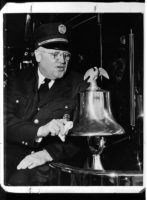 Frank Biermann
Frank Biermann
Born: 1896
Died: June, 1990
Frank Biermann came to Mount Prospect in 1911 when his father, a teamster, was hired by William Busse to grade and maintain the streets in Mount Prospect. Frank Biermann later married William Busse’s Daughter, Helen. Frank worked for William Busse in his store on the corner of Busse Ave. and Main St. In 1927, William Busse split up his store, forming Busse Buick and William Busse & Sons. He sold his farm implement business to Herman Meyn and his hardware store to Frank Biermann, creating Busse-Biermann Hardware. Frank Biermann was also very involved in local organizations. He joined the Mount Prospect Volunteer Fire Department in 1915 and served for 41 years. From 1928 to his retirement in 1956 he was Chief of the volunteer department. Frank Biermann was also a member of the Lions Club for 50 years and very involved with the Mount Prospect Historical Society.
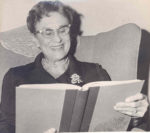 Meta Bittner
Meta Bittner
Born: November 6, 1900
Died: November 27, 1975
Meta Bittner grew up in Cairo, Illinois at the very southern tip of the state. Her grandparents, Whilemina and Jacob Walter had immigrated in 1852 and settled in this “small town with great expectations” in 1867. Meta moved to Mount Prospect in 1930 and began making waves as soon as she got here. She was very involved with the Mount Prospect Woman’s Club, serving as president for many years. She was also very involved with the Mount Prospect Public Library, which was originally founded by the Mount Prospect Woman’s Club. She was a member of the original board when the Library became a tax supported organization. She served on the Library board for over twenty years, from 1943 to 1965. Meta Bittner was one of the founders of the Mount Prospect Historical Society and served as its first president. She was also a charter member of the Executive Board of the Lutheran Woman Mission Endeavor of Northern Illinois.
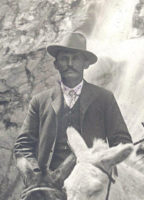 William Busse
William Busse
Born: January 27, 1864
Died: July 16, 1955
William Busse originally lived on a farm in Elk Grove Township. After being appointed Deputy Sheriff in 1890, he aspired to a future in politics and believed a location closer to the train would allow him to do this more easily. In 1894 he built his first home (now 808 E. Central). A Victorian style house, it was elaborate and included such impressive features as decorative iron work around a widow’s walk, a large formal living room and perhaps, most impressively, a large formal garden in the back of the house.
In 1900, William Busse was elected to the Cook County Board of Commissioners, and his prominent political career and role in the development of Mount Prospect began. In the 1890s, he helped found the Central School in Mount Prospect and in 1911 he was involved in the Mount Prospect Improvement Association. After the incorporation of the town in 1917, he became the first mayor of Mount Prospect. William Busse also largely influenced the commercial development of the downtown by establishing Busse Hardware and Busse Buick. Also, most importantly for the economy of the town, he established Mount Prospect State Bank in 1911, one of the few banks that survived the Great Depression without major setbacks.
As his children began to grow older, William Busse believed he no longer needed the large space that his first home provided. After giving his house to his son William Jr., he had a second house built on Emerson Rd. This house, now standing at 804 Central was the house in which William Busse lived until his death in 1955.
After William Jr. inherited the first house of his father, he moved the house to the location on Emerson and also turned it 90 degrees, making the side door the main entrance. This also prompted a change in the interior layout of the house which was made less formal. Throughout the years, the ornate iron work and Victorian decorations to the house have been stripped away as changes have been made to architectural tastes.
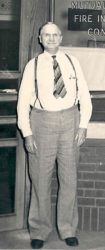 George Busse
George Busse
Born: December 5, 1874
Died: February 18, 1971
George Busse was a major developer in Mount Prospect. In 1923 he founded the Mount Prospect Development Association with his brothers, purchased the Owen Rooney Farm, and subdivided it into Busse’s Eastern Addition. In this subdivision Mount Prospect gained Owen Park, the first public park in the village. George Busse worked with the developers and the recently formed village government to enact strict zoning and building regulations in Mount Prospect, in the hope of keeping the developments on a sustainable scale. His business eventually developed into Busse Realty and stayed within his family for generations.
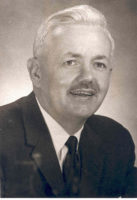 Mayor Daniel Congreve
Mayor Daniel Congreve
Daniel Congreve was Mayor of Mount Prospect from 1965 to 1969. He was a “Back to Basics” kind of Mayor. He ran on a platform of returning to the traditional values of the community and campaigned by riding around town in a horse drawn wagon. He is the only Mayor who left office with the boundaries of Mount Prospect unchanged, as the community did not expand at all during his administration. Part of the reason for this was that he spent much of his time in office involved in legal battles with Salvatore DiMucci, a regional developer. While he was in office, both his administration and the country as a whole were caught up in turbulence and social unrest.
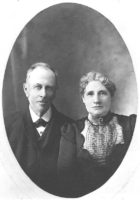 Ezra C. Eggleston
Ezra C. Eggleston
Born: 1837
Every town in the United States begins with a vision, ambition and investments. Mount Prospect’s beginning was no different. However, the person who had the initial vision, ambition and investment was not a member of the founding families that we recognize today. Ezra C. Eggleston, an investor and real estate broker, came across 140 acres of farmland along the Chicago and Northwestern Railway. He purchased the land from Walter Burke and Owen Rooney in 1874. There are several reasons why Eggleston chose this particular farmland to invest in, all of which have to do with location.
As the mode of transportation shifted from boat to train, so did the nature of land settlement. In the early 1850s, northwestern Cook County began discussing the possible construction of a railroad. It was approved by the Illinois legislature and the construction was complete in 1853. By 1854, the first train traveled from Chicago to Cary. Because of this railroad, the land along it increased in value, which piqued Eggleston’s interest.
Once Eggleston purchased the land from Burke and Rooney, he subdivided it into small parcels to sell for profit. Eggleston drew up a map of the land, naming it “Mount Prospect.” He called it “Mount” because it sat atop the highest elevation in Cook County. He felt that because it was along a rail road and because of its distance from Chicago’s swampland, it had many prospects. He built a rudimentary train depot about 14 feet by 16 feet. Without this train depot, Mount Prospect may have never evolved as it did.
However, the reason that Eggleston is somewhat forgotten is because he was never able to see his vision come to fruition. Two years before he purchased the land, the Chicago Fire destroyed homes and lives. Therefore, people were focused on rebuilding, not purchasing new land. The Great Depression of 1873 also deterred people from purchasing new land. Eggleston’s vision was also delayed because by this time, 73 percent of Cook County was within 15 miles of a railroad, lessening the appeal of his real estate. All of these factors caused Eggleston to declare bankruptcy, and he was forced to sell one of his blocks to William Mills. After settling his legal issues, Eggleston and his wife, Agnes, moved to Allegan, Michigan. One of Eggleston’s chief investors, Ripon College, declared that there seemed to be “little future in the Village of Mount Prospect.”
Despite the fact that his vision did not flourish as he had hoped, his actions were pivotal to the development of the Mount Prospect we know today. After he left, a man named Christian Geils purchased a triangle of the land and began to develop. He built the first general store which was located at the corner of Northwest Highway and Main Street (the building is now Capannari’s Ice Cream.) One by one, German settlers relocated from their Elk Grove farms to the developing Village of Mount Prospect.
Although Ezra C. Eggleston relocated his family to Michigan, some of his descendants moved back to Mount Prospect in the 1960s. Even though Eggleston abandoned what he thought was a failed vision, his efforts were a catalyst in Mount Prospect’s history, and his descendants and our community recognize that.
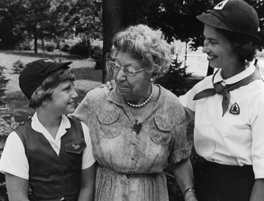 Bertha Ehard
Bertha Ehard
Born: May 12, 1883
Died: June, 1968
Bertha Ehard was a dynamo in Mount Prospect. In 1926 she started the Mount Prospect Campfire Girls, a girls club similar to the Girls Scouts. She worked in Chicago and would come home at night and rush over to the one room Central School house and hurry to build a fire in the potbellied stove to try to warm up the building before the girls got there. The group chose the name “Potawatomi” and received a charter from the national Camp Fire Girls in 1927. The organization fostered understanding and appreciation of nature, an interest in Native American history and responsibility to the community. The group was lobbied for and picked some of the unusual names of the streets in the southern half of Mount Prospect, such as Hi Lusi and Wapella. These were meant to be Native American words, although some of them have since turned out to be made up. Bertha Ehard was also a Charter member of the Mount Prospect Woman’s Club and a founder of the Mount Prospect Public Library. In 1945 she was elected a Library Director and Finance Chairman. She continued to serve as treasurer until 1963. She was a life member of the Chicago Art Institute and helped to organize the United Youth Fund Drive. Later in life a club for young women was named for her and the E-Hart Girls were born.
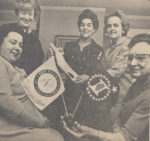 Gertrude Francek
Gertrude Francek
Born: July 11, 1913
Died: 1987
Gertrude Francek was the granddaughter of John Conrad Moehling, the owner of the first General Store in Mount Prospect and one of Mount Prospect’s greatest promoters. Gertrude Francek followed in her grandfather’s tradition and in 1931, at the age of 17, opened an Ice Cream Parlor, making her the first woman to run a retail business in Mount Prospect. Her grandfather had been Mount Prospect first postmaster, and in 1938 she also continued that tradition, becoming the Assistant Postmaster at the age of 25. She later became a real estate broker and developed many of the other interests and community ideas. She was a very athletic person, playing semi-pro basketball, touring with a bowling team, and golfing daily. She was one of the founding four members of the Mount Prospect Historical Society, president of the Salt Creek Questers Club and a founder of the Mount Prospect Business and Professional Women’s Club.
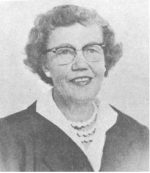 Dr. Louise Koester
Dr. Louise Koester
Dr. Louise Koester was the first doctor in Mount Prospect. She was born in Hanover, Germany and came to the U. S. in hopes of becoming a medical missionary in Africa. She attended Wheaton College studying medicine and dreamed of using her training in Africa. While looking for a hospital to complete her residency, she faced gender discrimination. It was hard for her to find a hospital that would allow her to train since the majority only allowed women to train as nurses. She learned about Mary Thompson Hospital which was the first all-women staffed hospital located in Chicago. Mary Thompson Hospital accepted Koester and she completed her training there.
Dr. Koester first heard of Mount Prospect through her friend and colleague, Dr. John Renner of Palatine. Dr. Renner told her of Mount Prospect’s need of a doctor in the growing community. She weighted her choices and decided that it was her calling to go to Mount Prospect and help the small community in need of a doctor, however she continued to contribute to missionary work, even donating enough money to build a hospital in Africa.
In 1926, Dr. Koester soon opened an office inside her house, charging two dollars for office calls and three dollars for house calls. Soon after Dr. Koester opened shop, another doctor also moved to town. Realizing the need for a hospital, Dr. Koester and Dr. Wolforth opened up the first hospital for accident victims. When asked what it was like being a doctor at the time Dr. Koester commented, “It was very hard to be a doctor then for there were no antibiotics and the training included making all of the medicines we gave to patients. Many times it was hard to decide what to do for a patient so I did my best and prayed.”
A local doctor was reported to have said: “She won’t stay there very long, she’ll last only two weeks or maybe a few months. Who wants to go to a woman doctor anyway?” After twenty-six years of dedicated service, the Village of Mount Prospect acknowledged Dr. Koester’s work in a special proclamation in 1965.
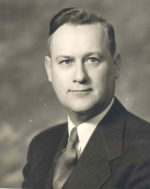 Mayor Theodore Lams
Mayor Theodore Lams
Born: November 11, 1905
Theodore Lams was Mayor of Mount Prospect through a large part of the post war boom. Lams had been a trustee from 1945 until he became Mayor in 1953. When he was Mayor, the population more than doubled and the developed area of Mount Prospect grew immensely.
One of the largest developments in Mount Prospect, Randhurst, started while Lams was Mayor. Although the grand opening happened the year after he left office, he was certainly involved in the development. When Randhurst was built, malls were a new idea and Randhurst was one of the largest. People came out from Chicago and all of the neighboring communities to wander around inside what was then the largest air-conditioned space in the country.
Lams may have been Mount Prospect’s most artistic Mayor. He received his Master’s Degree in Music and worked as a professor of Music at Northwestern University for the majority of his professional career.
He was also involved in other community organizations. He was a founder and board member of the Northwestern Suburban YMCA, one of the original organizers of North West Community Hospital, a long term member of the Mount Prospect Lions Club, and a president of the Saint Paul School Board.
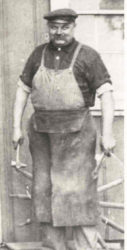 John Meyn
John Meyn
Born: January 7, 1863
Died: December 3, 1948
John Meyn was born in Schleswig-Holstein and immigrated to America in 1882 at the age of 19. He worked as an assistant blacksmith in Arlington Heights for a year before he was persuaded by John C. Moehling to move to Mount Prospect and open his own shop. He was the first blacksmith in town and ran the business for many years. His shop in Mount Prospect was located on Northwest Highway, just past Main Street. Having a blacksmith shop was an early step towards development. When most transportation required horses, a town needed to have someone who could shoe the horses and repair wagons in town if the town was expected to grow.
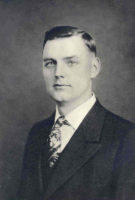 Mayor Herman Meyn
Mayor Herman Meyn
Born: November 28, 1889
Died: 1965
Herman Meyn, was Mount Prospect’s second mayor. He was the son of Mount Prospect’s first Blacksmith, John Meyn. Herman Meyn was also trained as a blacksmith and began working as a blacksmith in 1914. He bought his own business in 1924 and still had an active foundry business when he became mayor. Changing with the times, he later expanded his business to include farm implements and eventually lawn movers.
Herman Meyn was one of the first people born in Mount Prospect. When he was born, the town was only what we think of as downtown. There were only three shops in town and with his six brothers and sisters, his family made up a large percentage of the town’s population.
He was involved with many aspects of the community. He was a charter member of the Mount Prospect Volunteer Fire Department and served on the force for many years. He was the fourth Fire Chief in Mount Prospect, holding that position for nine years, or from 1922 until he became Mayor. Even with the added responsibility of being the head of the Village Board, he remained active in the Fire Department throughout his term, putting in a total of 17 years on the force.
Soon after Herman Meyn became Mayor of Mount Prospect, the U.S. economy went into its longest and most severe recession, the Great Depression. Meyn stayed as the Mayor through the entire crisis. In that time Mount Prospect became known as one of the most responsibly run communities in Illinois. It was one of very few communities in the area that remained solvent throughout the 1930s. Meyn was even able to make some civic improvements during these difficult times. In 1935 he oversaw a water reservoir to better serve the community needs.
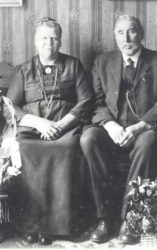 John C. Moehling
John C. Moehling
Born: October 15, 1850
Died: September 3, 1939
John C. Moehling owned the first store in Mount Prospect. It was a small general store located at the corner of Main Street and Northwest Highway. The store was originally started by Cook County Commissioner Christian Geils. However, Geils soon found out that running a general store was not his calling in life. While Geils was discovering that he did not like running a general store, a man named John Conrad Moehling was in Elk Grove discovering that he did not like farming. In 1882 the two came together and Moehling bought the store. He found that he did enjoy being a store keeper and he soon became a pillar in the community. He began selling farm tools, coal, seed, feed, groceries, shoes, etc. He also built a warehouse along a side track to help bring in and ship out materials.
John C. Moehling was one of Mount Prospect’s biggest promoters. Throughout his career he worked hard to improve Mount Prospect and bring in new services and businesses. He persuaded John Meyn to move to Mount Prospect and start a blacksmith shop. Meyn had been working as an apprentice in Arlington Heights and was ready to move on to his own shop when Moehling approached him and offered to build him a new shop in downtown Mount Prospect. Moehling also convinced the Chicago Northwestern Railroad to build a new Depot in Mount Prospect and was appointed the first depot agent, a position he held from 1887 until 1902. In 1875 he was a charter member of the Mutual County Fire Insurance Company of Mount Prospect, in 1884 he organized the Jefferson Democratic Club, and in 1895 he was one of the founders of the Central School and District 57. Moehling was also appointed the first Postmaster of Mount Prospect on December 31, 1885 and based the local post office in his store. He served as Postmaster for twelve years or until 1897. According to legend, Moehling was also the person who brought dairy cows to Mount Prospect. Seeing that the area was appropriate for milk cows, he went off in search of the best breed and eventually brought them back, kicking off Mount Prospect’s role as a major dairy center.
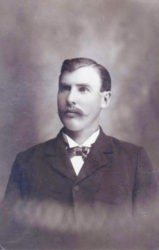 John P. Moehling
John P. Moehling
Born: December 4, 1875
Died: July 26, 1947
John P. Moehling was the son of John Conrad Moehling, and like his father he spent years of his life working to improve Mount Prospect. In 1917 he was Mount Prospect’s first Police Magistrate and later, in 1929 worked as the Village Collector. He was a charter member of the Mount Prospect Lions Club. Between 1913 and 1916 he was the secretary of the Board of Education for the short lived Mount Prospect High School. He also served as a democratic election judge for 32 years. Similar to his father, he worked in a number of different fields. He formed a real estate brokerage firm in the 1920s. He built a Standard Oil Service Station on the corner of Northwest Highway and Main St., the first full service station in Mount Prospect. He also continued his father’s general store business and expanded it by becoming an agent for the International Harvester Company, Deering Division. He later changed with the times and shifted from selling plows to selling lawn mowers.
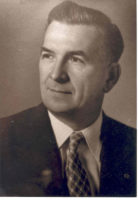 Mayor Maurice Pendelton
Mayor Maurice Pendelton
Maurice Pendelton was the Mayor of Mount Prospect through the start of the huge post war boom in suburban construction. When he came into office, World War II was just coming to an end. From there he watched as development in the area went from a slow trickle to a tidal wave. Professionally, Pendelton worked as a publisher. He owned his own publishing business in Chicago, which specialized in printing lumber and wood working trade journals. He took this experience and used it to print the Prospector, Mount Prospect’s first newspaper.
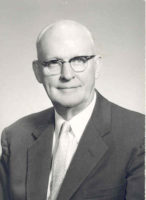 John Pohlmann
John Pohlmann
Born: 1889
John Pohlman was born in Mount Prospect in 1889. He had fifteen siblings and his family therefore made up a large percentage of Mount Prospect’s population, which was still fewer than 100. At the age of 6, John Pohlmann became one of the first 5 students to attend the Central School, Mount Prospect’s first school. At 20 he became the Station Master for the Chicago Northwestern Railroad in Mount Prospect. He worked in the Mount Prospect train station for the next 45 years. He was one of the organizers of the Mount Prospect Improvement Association and then was later one of the first Board of Trustees. He was also a charter member of Saint Paul Lutheran Church and the Mount Prospect Volunteer Fire Department.
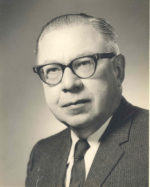 Mayor Clarence Schlaver
Mayor Clarence Schlaver
Born: 1905
Died: February 12, 1980
C. O. Schlaver grew up on a farm in Sparta, Wisconsin. From this “hands on” experience, he learned to hate farms. He moved off the farm, went to the University Of Wisconsin School Of Journalism and headed off to become a reporter. He moved to Mount Prospect and was much better known as a journalist, activist and politician. Clarence Schlaver was involved in local politics for thirty years in a number of different roles. He was a Village Trustee for seven years beginning in 1954 and ending when he was elected Mayor in 1961. He founded the Good Neighbor Party in local politics, a group dedicated to the extension of services in the community. Through his leadership and the actions of the party, many of the municipal and educational services we have come to rely on were started.
C.O. Schlaver worked in the newspaper business in one form or another for many years. He was for a time a reporter and editor for the Star-Courier and later on the editorial staff of the Chicago Daily News. He printed his own small newspaper on Mount Prospect for a number of years, as well as helping a number of local students put together their own papers. He was the first full time editor of “The Quill” the monthly publication of Sigma Delta Chi, the national professional journalism society.
Schlaver was also involved with a number of other organizations. In 1972 he became the Executive Director of the Mount Prospect Chamber of Commerce a position he held until 1979, shortly before his death. He was a founding member of the Mount Prospect Historical Society, and involved with the Lions Club both at a local and state wide level.
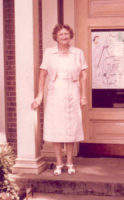 Irma Schlemmer
Irma Schlemmer
Irma Schlemmer was the Head Librarian for the Mount Prospect Public Library in the early years of its existence. She was influential in the campaign to make the Library a tax supported organization. She later worked as a trustee for the Library. She was a president of the Mount Prospect Woman’s Club, the organization that first organized the Library. She was also a member of Saint Paul Church and the Saint Paul Ladies Aid Society.
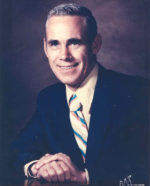 Mayor Robert Teichert
Mayor Robert Teichert
Born: 1924
Robert Teichert was a progressive community leader and politician in Mount Prospect. He was a major supporter of the Library, purchased the Village Hall, established paramedic service and a central dispatch system for Mount Prospect, lobbied for adopting the Village Manager system of government, and campaigned on a platform of open government and full disclosure. He was elected a Trustee in 1965 and served for four years until he became Mayor in 1969. He served for eight years as Mayor of Mount Prospect, in a time when the community was going through a difficult adjustment. The post war boom was over, the population of the community was aging, school enrollment was far down, and the municipal budget was over extended. Teichert and the Trustees struggled with these problems over the years, bringing the community back to a stable position.
Teichert was responsible for the single largest annexation in Mount Prospect history. The area of New Town added almost 2 square miles and close to 10,000 people to Mount Prospect. Although there was an animated discussion about the annexation, in the end the Village Board voted unanimously to absorb the unincorporated area.
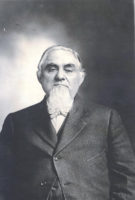 William Wille
William Wille
Born: November 1846
Died: September 21, 1927
William Wille was one of the most influential people in the development of Mount Prospect. He had a number of different jobs over the years, but he was always involved in community matters. In 1880 he started Wille’s Cheese Factory at the intersection of Northwest Highway, Busse Ave and Wille Street. He would buy milk from local farmers, turn it into cheese and butter and then take it into Chicago for sale. After about twenty years of doing this he got tired of all the trips in and out of the city, particularly in bad weather, and closed the business in 1902. In 1895 he and William Busse were the primary forces behind getting School District 57 founded. After it was founded, William Wille and William Busse both donated land to create a small campus for the first school and William Wille was hired to build it. Central School, the one-room school house is still standing today, demonstrating his workmanship. In 1905 Wille and Busse teamed up again and re-subdivided the original Eggleston triangle, making the plots more attractive and bringing in new residents. In the early 1900 William Wille also built and started Wille’s Tavern, which he ran up until prohibition, when he gave it to his son who made it into Wille’s Buffet. William Wille also built Wille Hall, which was essentially the first community building in Mount Prospect. It was used by club meetings and community dances and gatherings.
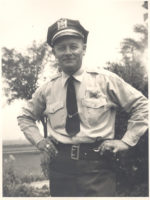 George Wittenberg
George Wittenberg
Born: August 1, 1900
Died: November 10, 1969
George Whittenberg was the second police officer in Mount Prospect and the second Chief of Police. He was hired by William Mulso, Mount Prospect’s first Police Chief who was the entire police force from 1924 until he hired Whittenberg in 1932. Five years later, Whittenberg became the Chief of Police, a position he held until he retired. Whittenberg was originally hired, in part, because he could ride a motorcycle. The Police Department had one motorcycle and one 1929 Pontiac. George Whittenberg served on the Mount Prospect Police Department for 33 years, and was the Chief of Police for most of that time. He resigned his post in 1965, having seen the community change dramatically during his tenure. When he took the job, there were no paved roads and the population was about 1200. By the time he retired, the population was over 25,000, Mount Prospect was twice as large, and the police force had grown from two officers to almost thirty. Four years after he retired, he died. His funeral procession consisted of fifty cars that passed by the Police Station one last time. Whittenberg was a long time member of the Mount Prospect Lions Club, and following his death, the Lions donated $6000 to the Village to erect a memorial. In 1975 the Village built a waterfall and fountain at the base of the water tower, as a memorial to his years of service. The memorial stood very close to the police station in which Whittenberg had spent so much time.